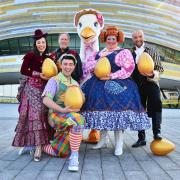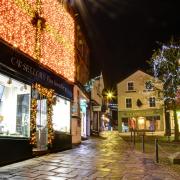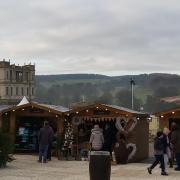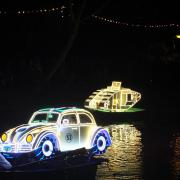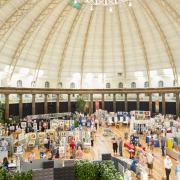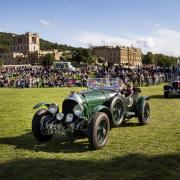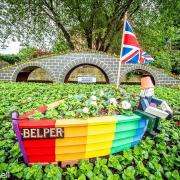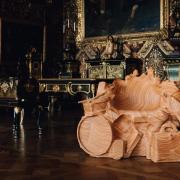Pat Ashworth tours the garden at Melbourne Hall in company with Lady Ralph Kerr

When Lady Marie-Claire Kerr talks about how her vision for the Melbourne Hall gardens is being realised, you can tell that she is seeing it all through a painter’s eye. It is as though she is standing in front of the landscape with a palette and easel and dabbing in the colour – a splash of pink here, a blaze of yellow there. Distinguished artist that she is, one day she will find time to paint it in reality, but for now, she is content to create new things within a garden where, botanically speaking, ‘little had happened for almost 100 years.’
That’s not to say that these formal gardens were ever anything less than impressive – the historian, Philip Ziegler, has described them as ‘as close to perfection as any in the country.’ They were laid out in the manner of Louis XIV’s gardener, André Le Nôtre, who designed and constructed the park of the Palace of Versailles, and the great sweep of lawn and terrace that draws the eye to Robert Bakewell’s wrought iron ‘Birdcage’ arbour, is early 18th century perfection.
It has been satisfying, she says, to see the original perspective restored in the re-opening of a bricked-up door in the wall behind the Birdcage and the placing of a small bridge across the brook – both restoring the original link between the garden and the rising parkland beyond the hollow. The view between the two islands of the tranquil Mill Pond, viewed from the elevated position of the terrace, is also unimpeded now after much clearance. Lady Kerr came here in 1988, when she and Lord Ralph were married, and she says, ‘I was always knocked out by the serenity of the garden. It was an imaginative, peaceful place – a treasure, really.’ She comes from Fife, from parents who also had a passion for gardens and whose influence and support are embodied and fondly remembered in some of the planting here. Early memories of her childhood include the scaling of an immensely high wall around an ancient walled garden, in the company of her brother: a balancing act ‘like Peter Rabbit’ that in retrospect she certainly wouldn’t have advised for any of her own six children, she reflects.
The long, mysterious, atmospheric yew tunnel we are strolling through was planted in 1740 as a walk between two yew hedges: with the branches so tall and arched, it now takes a cherry-picker to do the annual clipping. We emerge into one of the most transformed areas of the garden, the colourful, herbaceous plot that has been cleared and planted from a density of laurel, holly and yew. It is dominated by a tree Magnolia that produces handkerchief-sized blooms in the spring, a species that mostly grows in Wales, Cornwall and the west coast: ‘We’re so lucky we have a kind of microclimate here that enables us to grow things we probably couldn’t in other parts of Derbyshire,’ Lady Kerr observes.

Imaginative planting here is enabling all-year-round colour, from the Primulas and Hostas of spring to the stunning pinks and deep reds of autumn Asters. ‘We’re getting a lot more colour co-ordinated,’ she says with satisfaction. It is the painter speaking again. The ‘we’ is the partnership with full-time head gardener, Kathryn Robey, whom Lady Kerr credits with bringing a level of expertise and knowledge that has enabled so much of the work to be done. Kathryn also has the invaluable assistance of Adam Smith, Robert Henfrey and Penny Swan.
‘She has added a magic touch. It’s lovely working with someone who thinks alike and intuitively knows. She knows what that “something” ought to be; we see the same thing with our mind’s eye,’ she says warmly. ‘I’ll sometimes say, “I was thinking perhaps if we planted that with that...” and Kathryn will say, “We did it yesterday.” She’s taken it all to a new level and given us an opportunity to do what we have always wanted to do.’ The many projects on the drawing-board include plans for a formal, fragrant rose garden in this area, after old redcurrant bushes and raspberry canes have been removed at the end of the year.
The bog garden too has round-the-year colour now in these gardens, always open to visitors from April to September but traditionally at their best in May. White and cream shrubs will be appearing here in ‘a secret bit’, Lady Kerr says with pleasure, pointing out the beautiful white beech on the bog bank.
A sudden rainstorm descends, contradicting the brilliant sunshine, and the three of us flee through the tall, tall trees that bring surprise vistas at every turn, to take refuge in the greenhouse. Here in the old walled garden where it stands, a newly formed Potager is starting to take shape adjacent to the paddocks that have been added over the years to this very family-oriented home. The sunlight pours through the rain, prompting Kathryn to ponder, ‘We ought to have a garden photography course, really early in the morning when the light is just right. It would blow people away.’

The rain stops as suddenly as it started and the sound of trickling water draws us to the three ponds of the original design: one circular, one star-shaped and one in the shape of a flower. Now we are in the arboretum that Lady Kerr has created over the last few years, planted with a sequence of bulbs that will see Fritillaria and Scilla yield to Allium and tulip. Getting ‘the bulb bit’ right wasn’t easy, both agree: grass that proved to be too coarse and vigorous had to be killed off and re-seeded after a period that saw too much cold and no rain. But now it is thriving and giving the thrill that sudden blossoming always brings: the feeling that if you could watch plants all night, you would actually see them bursting into bloom. ‘It’s so amazing the speed with which it happens,’ Lady Kerr says with pleasure.
In line with prevailing fashion, the enthusiastic Victorians planted laurel everywhere at Melbourne, even a line dividing the top of the garden from the bottom. Lime trees planted in the park were never in line with the garden, and two large Corsican pines, since felled, were completely out of line with the Birdcage, especially after the planting of the avenue. But we pause and marvel at a great evergreen oak and Kathryn observes, ‘It’s a beautifully shaped tree, stunning, solid and strong. Whoever planted that did a good job.’ How sad they never saw it, we reflect, but hope they realised at the time what a mighty tree it would become.
We are almost full circle, treading a mossy path that is like walking on carpet as we approach the small winter garden that has been created by the house.
When I listen to my recording later, I find it full of birdsong, like the soundscape to a nature programme, something that lifts the heart and completes the glory of a garden. Sometimes, Kathryn says, when visitors walk round with heads down, deep in conversation, she has an urge to shout, ‘But look around you! Look!’ But generally, it’s immensely rewarding to have the visitors, they say, and that’s the point of doing it all – so that so many people who are interested can come and see it. They plan more garden tours for groups, perhaps even a Friends of Melbourne Hall Gardens. ‘Kathryn has lifted the public face of the garden, and the real achievement over the last few years has been getting it ready for the whole season we are open,’ Lady Kerr says. ‘To make it really interesting right the way through – that’s the challenge.’
A new generation has a stake in it too. Six-year-olds from nearby Grace Dieu preparatory school planted poppies in commemoration of World War One and returned to see them in bloom. And maybe one day, Lady Kerr will paint it – when the intensity of her work no longer takes her to London several days a month. ‘My eldest son keeps saying, don’t take any more commissions, you should paint a series of pictures of the garden,’ she says with a smile. ‘I’m going to do it. I’m definitely going to do it.’
Melbourne Hall and Garden
The House is open every day of August only (except the first three Mondays) from 2pm, last entry 4.15pm
The Gardens open April to September, 1.30-5.30pm on Wed, Sat, Sun, Bank Hol Mon and during August when the Hall is open. Tel: 01332 862502. Melbourne Hall recently launched its website www.melbournehall.com and can be followed on Facebook at www.facebook.com/MelbourneHallUK








